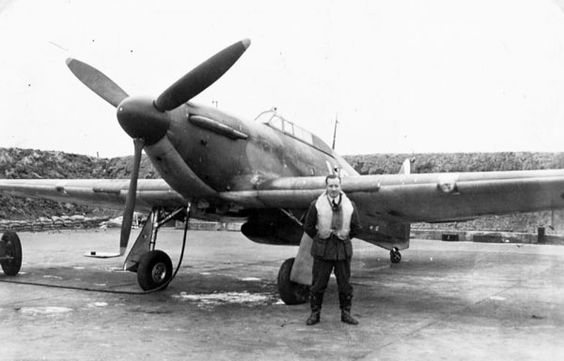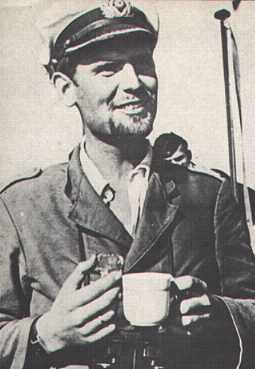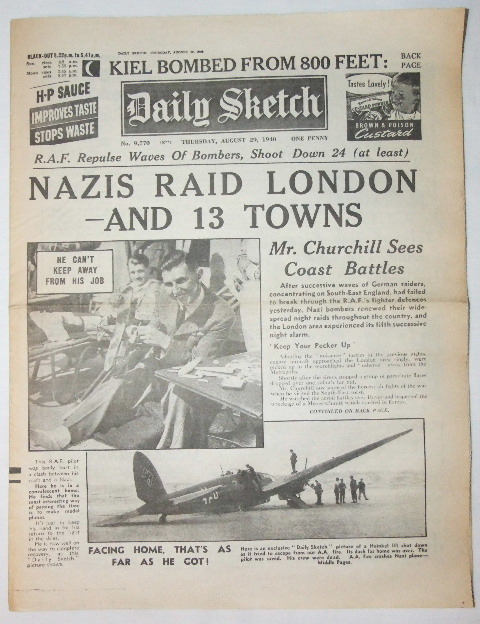Thursday 12 September 1940
 |
| Lascaux cave paintings from 17,000 years ago are discovered on 12 September 1940. |
- That properly targeted terror bombing will inflame class divisions between rich ("plutocrats") and poor; and
- That terror bombing will destroy civilian morale and force negotiations.
From a military perspective, the German change in strategy from bombing RAF infrastructure to cities already is known to be ineffective. Air Vice-Marshal Keith Park of No. 11 Group writes in a memo that:
confidence is felt in our ability to hold the enemy by day and to prevent his attaining superiority in the air over our territory, unless he greatly increases the scale or intensity of his attacks.Fighter Command statistics as of 0900 hours 12 September 1940 show the following operational status:
- Blenheim - 50
- Spitfire - 208
- Hurricane - 392
- Defiant - 21
- Gladiator - 8
- Total – 679
This is not to downplay the deaths, the suffering, and the damage to buildings old and new alike. Historic buildings made of wood tend to be dry and easy to burn. However, the RAF is recovering, rebuilding its shattered airfields, repairing its radar installations, replacing aircraft, and restoring aircraft production.
 |
| S/L Ernest A "Ernie" McNab of RAF No. 111 Squadron, pictured with his Spitfire at RAF Northolt on 12 September. |
Around mid-day, a few small raiders attack the Fairlight radar station, without result. Another raid damages Harrogate, in particular, the Majestic Hotel, apparently targeting the nearby Ministry of Aircraft Production building and causing 15 casualties. Tunbridge Wells also takes damage, while RAF Hornchurch is bombed, with many bombs falling errantly on nearby houses (not a good place to live near at that time).
Hastings is bombed around 14:40, and the Luftwaffe planes strafe the area as rescue operations are in progress. Hampshire and Wiltshire also receive some hits. Rail service is interrupted near Reading due to a random strike on the rail line.
At dusk, III,/KG 51 and I,/KG 54 send about 50 bombers across to bomb London, while a few bombers from III,/KG 27 bomb Liverpool. After dark, there are further raids, but it is nothing like previous nights. Two Luftwaffe bombers are brought down, one by the Balloon Barrage at Monmouthshire and another by London flak (which quickly is becoming concentrated as nowhere else in Europe).
Lieutenant Robert Davies and sapper George Cameron Wyle of the British Royal Engineers disarm an unexploded one-ton bomb buried deep beneath the pavement at the southwestern corner of St. Paul's Cathedral in London. Davies drives it to the countryside to detonate it. The two men receive the George Cross medal, which is unusual because it is intended for civilians.
Overall, losses are minimal, at least compared to previous days, with losses by the RAF in the single digits and those by the Luftwaffe not much higher. The fighter pilots on both sides basically get the day off.
 |
| An "abandon ship" drill on HMS Kelvin, 12 September 1940. © IWM (A 685). |
Other targets are the industrial centers/marshaling yards of Osnabruck, Hamm, Schwerte, Ehrang, and Brussels. Hamm is hit for the 6th time. Individually, the raids do not cause much damage and bombing accuracy is poor, but in some locations, the damage is starting to accumulate.
The Kriegsmarine admits in a report that the British attacks are hurting its efforts to assemble an invasion fleet. To date, the Germans have assembled about 1000 barges in the ports, and they provide tempting targets. However, despite the losses, the number of barges for Operation Sealion continues to grow.
Battle of the Atlantic: British 2444 ton tanker Gothic hits a mine 7500 yards southeast of Spurn Head, Yorkshire, and sinks. Half of her 24-man crew perishes.
Royal Navy Tug 1164 ton Salvage King runs aground off Duncansby Head, Scotland and is a total loss.
Force Y of the Vichy French Navy, which passed through the Straits of Gibraltar on the 11th without British interference and stopped for the night in Casablanca, leaves port at 04:00. Eluding a shadowing British force led by battleship HMS Renown, the three fast cruisers and accompanying destroyers speed down to Dakar in French West Africa. The British continue their bumbling pursuit, not even realizing that the cruisers have left until the Renown's floatplane can't find them in the Casablanca harbor and instead spots them far to the to south. The Admiralty dispatches the aircraft carrier Ark Royal from Freetown, accompanied by three cruisers, to intercept the French from the south - the British not knowing for certain that Dakar is Force Y's ultimate destination. Of course, the British are planning Operation Menace for Dakar, so that is the last place they want the cruisers to go.
The Liverpool raids the Liverpool harbor and damages freighter Tintern Abbey, Royal Navy storeship Glenroy and troopship HMT Highland Princess.
Convoys OA 213 and MT 167 depart from Methil, Convoy FS 279 departs from the Tyne, Convoy LG 1 departs from Liverpool, Convoy BS 48 departs from Suez.
Corvette HMS Heliotrope (K 03, Lt. Commander John Jackson) is commissioned.
U-153 and U-407 are laid down.
Battle of the Mediterranean: The Italian 10th Army continues marching toward the Egyptian border, harassed by the RAF. It is a slow advance, held up more by the pace of Italian foot soldiers more than anything the British are doing.
On Malta, the military prepares for heightened military activity due to the overall war situation. The War Office instructs Governor Dobbie to raise more men from the local population to man the anti-aircraft guns.
Applied Science: The Tizard Mission team members have all crossed the Atlantic with their equipment, and today it holds a meeting in Washington D.C. with its American counterparts.
War Crimes: Wing Commander J.S.Dewar, D.S.O., D.F.C. of RAF No. 213 Squadron makes a personal flight from RAF Exeter to Tangmere during the quiet morning period. He disappears, and his body eventually washes up at Kingston Gorse, Sussex on 30 September 1940. There is a rumor/belief that enemy aircraft shot down his Hurricane and machine-gunned him in his parachute. This incident is not offered as an actual war crime, because there is no proof of this, however, this is the sort of atmosphere in which pilots on both sides are operating. The air war, an area of unusual gallantry in both world wars, has a potential sharp edge that pilots of both sides recognize.
German/Finnish Relations: The two countries sign their agreement granting the Germans transit rights within the country.
US/Japanese Relations: A Japanese trade delegation arrives to negotiate increased deliveries of raw materials to Japan from the Netherlands East Indies. US Ambassador to Tokyo Joseph Grew and Secretary of State Cordell Hull confer about the implications of US oil sanctions on Japanese aggressiveness. Grew sees the likelihood of Japanese adventurism if the sanctions are too severe. There is no agreement reached during the meetings.
US Military: The Greenslade Board departs Norfolk, Virginia for St. John's, Newfoundland to inspect the new US base there (obtained in the destroyers-for-bases swap).
Hungary: The Hungarian army completes the occupation of the territories in northern Transylvania Maramures and part of Crisana given to it in the Second Vienna Award.
Romania: The Germans establish a military mission in Bucharest with the stated purpose of training the Romanian military. The real German interest is in the Romanian oil fields, which fuels the Wehrmacht and which Adolf Hitler obsesses over. New leader Ion Antonescu, meanwhile, is busy reaching an agreement with Iron Guard leader Horia Sima.
Canada: Order in Council 4751 makes foreign sailors on foreign ships in Canadian ports subject to imprisonment.
Holocaust: The Warsaw Ghetto for Jews, the wall already constructed, is formally approved by Gauleiter Hans Frank in occupied Kraków. This is conceived as a somewhat temporary solution, with the more permanent solution (at this point) foreseen as forced resettlement of Jews to the French-administered island of Madagascar in the southern Indian Ocean (originally, and perhaps ironically, an idea of the Polish government itself in the late 1930s). The Poles, however, determined that the island could not support more than a few thousand such refugees, and there are about half a million Jews in occupied Poland.
 |
| Robot the Dog, the true discoverer of the Lascaux cave. |
American Homefront: There is a suspicious explosion at the Hercules Powder Co. in Kenvil, New Jersey. There are 49 deaths and 200 other casualties.
In a typical Hollywood quickie marriage, Lana Turner and Artie Shaw, married on February 13, 1940, are divorced today after only seven months of marriage.
Future History: Mickey Lolich is born in Portland, Oregon. He becomes a top pitcher (3x All-Star) with the Detroit Tigers in the 1960s and then stars for other teams. In his biggest game, he wins Game 7 of the 1968 World Series against Bob Gibson. Lolich later runs a doughnut shop in Lake Orion, Michigan., which comports with his "everyman" attitude toward life.
Linda Gray is born in Santa Monica, California. She becomes a model in the 1960s, becomes a frequent television guest star in the 1970s, and then achieves Hollywood immortality ast Sue Ellen Ewing on CBS drama "Dallas." One of her lesser-known claims to immortality is that her legs are the ones featured on the posters for classic Dustin Hoffman film "The Graduate" in 1968. She remains active in the industry as of this writing, appearing, for instance, in British Channel 4 soap opera "Hollyoaks" as Tabitha Maxwell-Brown in late 2016.
 |
| The Beaufort News, September 12, 1940, North Carolina Newspapers. Not too much going on in that far-off European war, the big news is the back-to-school day. |
September 1, 1940: RAF's Horrible Weekend
September 2, 1940: German Troopship Sunk
September 3, 1940: Destroyers for Bases
September 4, 1940: Enter Antonescu
September 5, 1940: Stukas Over Malta
September 6, 1940: The Luftwaffe Peaks
September 7, 1940: The Blitz Begins
September 8, 1940: Codeword Cromwell
September 9, 1940: Italians Attack Egypt
September 10, 1940: Hitler Postpones Sealion
September 11, 1940: British Confusion at Gibraltar
September 12, 1940: Warsaw Ghetto Approved
September 13, 1940: Zeros Attack!
September 14, 1940: The Draft Is Back
September 15, 1940: Battle of Britain Day
September 16, 1940: italians Take Sidi Barrani
September 17, 1940: Sealion Kaputt
September 18, 1940: City of Benares Incident
September 19, 1940: Disperse the Barges
September 20, 1940: A Wolfpack Gathers
September 21, 1940: Wolfpack Strikes Convoy HX-72
September 22, 1940: Vietnam War Begins
September 23, 1940: Operation Menace Begins
September 24, 1940: Dakar Fights Back
September 25, 1940: Filton Raid
September 26, 1940: Axis Time
September 27, 1940: Graveney Marsh Battle
September 28, 1940: Radio Belgique Begins
September 29, 1940: Brocklesby Collision
September 30, 1940: Operation Lena
2020






